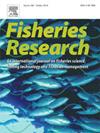基于机器学习和多元统计修正欧洲捕鱼船队的划分
IF 2.2
2区 农林科学
Q2 FISHERIES
引用次数: 0
摘要
考虑到过度捕捞导致种群过度开发这一关键问题,欧盟建立了数据收集框架(DCF)。在 DCF 框架内,成员国收集并分析与可持续渔业管理相关的数据。为了评估渔业状况,有必要将捕鱼船队分为船队分段。然而,目前的 DCF 划分主要基于船舶技术参数,如船舶长度和主要渔具,而这些参数往往不能准确代表船舶的捕捞活动。为了解决这个问题,我们开发了另一种船队划分方法,可以更真实地概括捕捞活动。这种方法利用多元统计并结合机器学习技术实现自动化。将这种方法应用于二十年的德国渔业数据,得出的数据集与 DCF 方法相比,分段更少,更贴近实际捕捞策略。对当前和新型分段方案计算出的生物种群健康指标进行比较后发现,当前方案往往会遗漏依赖于过度开发的种群的分段迹象。应用的机器学习技术显示出很高的分类准确性,误分类很少发生,而且只发生在渔获量构成重叠的部分。由于机器学习几乎可以完美地分配到修订后的分段,我们期待在未来的船队分段中成功实施这一方案。这种方法非常适合数据收集和分析程序,可以作为一种标准工具。因此,这种新方法有助于改进渔船队分析和政策建议,从而改善渔业管理。本文章由计算机程序翻译,如有差异,请以英文原文为准。
Amending the European fishing fleet segmentation based on machine learning and multivariate statistics
Considering the critical issue of overexploited stocks due to overfishing, the EU’s Data Collection Framework (DCF) was established. Within the DCF, member states collect and analyze data relevant to sustainable fisheries management. To evaluate the status of fisheries, it is necessary to categorize fishing fleets into fleet segments. However, the current DCF segmentation is primarily based on technical vessel parameters, such as vessel length and predominant fishing gear, which often do not accurately represent the fishing activities of the vessels. To address this, we developed an alternative fleet segmentation approach that provides a more realistic overview of fishing activities. This approach utilizes multivariate statistics and is coupled with machine learning techniques for automatization. Applying this approach to two decades of German fisheries data resulted in a data set with fewer segments compared to the DCF approach, which represented the actual fishing strategies more closely. The comparison of biological stock health indicators calculated for both the current and the novel segmentation schemes revealed that the current scheme often misses signs of segments relying on overexploited stocks. The machine learning technique applied showed high classification accuracy, with misclassifications being rare and only occurring in segments with overlapping catch composition. Since machine learning enables almost perfect allocation to the revised segments, we expect a successful implementation of this protocol for future fleet segmentation. This approach is highly suitable for data collection and analysis procedures and can serve as a standard tool. Therefore, this novel approach can contribute to the improvement of fishing fleet analyses and policy advice for better fisheries management.
求助全文
通过发布文献求助,成功后即可免费获取论文全文。
去求助
来源期刊

Fisheries Research
农林科学-渔业
CiteScore
4.50
自引率
16.70%
发文量
294
审稿时长
15 weeks
期刊介绍:
This journal provides an international forum for the publication of papers in the areas of fisheries science, fishing technology, fisheries management and relevant socio-economics. The scope covers fisheries in salt, brackish and freshwater systems, and all aspects of associated ecology, environmental aspects of fisheries, and economics. Both theoretical and practical papers are acceptable, including laboratory and field experimental studies relevant to fisheries. Papers on the conservation of exploitable living resources are welcome. Review and Viewpoint articles are also published. As the specified areas inevitably impinge on and interrelate with each other, the approach of the journal is multidisciplinary, and authors are encouraged to emphasise the relevance of their own work to that of other disciplines. The journal is intended for fisheries scientists, biological oceanographers, gear technologists, economists, managers, administrators, policy makers and legislators.
 求助内容:
求助内容: 应助结果提醒方式:
应助结果提醒方式:


